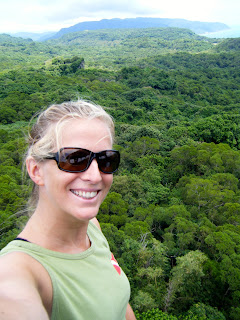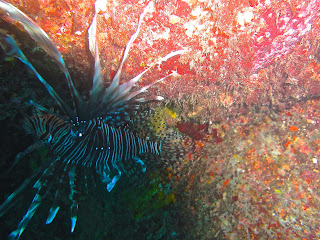As you have likely gathered from my lack of posts this week, I have been a bit busy finishing everything. I leave Taiwan in 5 short days, and today is my last day at the National Museum of Marine Biology and Aquarium. Upon return (likely written on the flight home) I will write an undoubtedly reflective and summary post before beginning writing about my next adventures. So for now I want to share with you some of the activities I have done the last few days here in southern Taiwan.
Last Thursday Chieh-Wen and her friend Kuan-Ju took me out on a night adventure. This was in part to thank me for helping with English translations for the National Park (where Kuan-Ju works) but mostly because they are just incredibly nice people. We started the night with dinner and an attempt at star gazing through some pretty heavy cloud cover. But then they took me up into the national park "Coral Reef Mountain" (more on that one later) to see glowing mushrooms. These mushrooms are only seen in two areas in Taiwan and grow only on bamboo. Adding to their mystery, the mushrooms (like all mushrooms) only appear when the air is very moist after big rains. Thank you typhoon season! Walking the trails at night is an entirely different experience. The critters that come alive at night are alien in appearance and seem to stare at you from their perches in the rock crevices. Here are some of those we saw walking into the bamboo stand:

(I thought these crickets were incredibly cute, like something out of a cartoon)
(Poisonous snail)
(Do you see it there slithering across our path? SNAKE!)
So being a terrible photographer I was not able to get a shot of the glowing mushrooms, but as I have a somewhat decent way with words I can describe it. Walking up I was expecting the "glowing" mushrooms to just give off a faint glow that you must squint and turn your head to the left to see. Boy was I wrong! Another group was already there, with a bunch of flashlights on blocking any view of these mushrooms. Luckily Kuan-Ju knew the group and asked them to turn off their lights. As my eyes adjusted I saw what looked like neon green glowsticks stuck all over the trees. There was nothing faint about the glow of these mushrooms. It reminded me of those glow-in-the-dark stars we all had on our ceiling as kids. But these stars were fresh out the package and Mom had just turned off the lights.
After a few days of working non-stop to finish presentations, molecular work, and showing the students here how to continue my work when I leave, Chieh-wen took me hiking in the "Coral Mountain" at Kenting National Park on Sunday. Taiwan is a relatively new geologic structure and in not too distant of a past the island was submerged as a coral reef and then built up by volcanic action. So here in southern Taiwan the hills, mountains, and cliffs are actually ancient coral structures. Our hike did not last too long as it was incredibly hot, but it was very interesting while it lasted.
(Beginning of the hiking path)
(Beautiful flowers along the path)
(Palms along the path)
(Path between the ancient reef structures)
(I was looking for more of the crickets!)
(Steps up to the Skyward Pavilion)
(You can somewhat make out Orchid Island on the horizon)
(Me at the top)
(The random coral structures just blew my mind)
(More pretty flowers)
(Cocoon)
(More mushrooms)
After the hiking adventure we went to the southern point of Taiwan to see the Eulanbi Lighthouse up close. It definitely looks much larger from the water when it is casting its light.
(Path to the Lighthouse)
(I love Taiwan!)
On Monday, my lab had a going away party for me at the Happy Panda, a really cool beach campground/restaurant/nightclub. Your group reserves a large picnic bench with a grill built in and they bring you the food to cook or you can bring your own as well. I will never forget how kind everyone here has been to me.
(Taiwanese BBQ time)
(With William, my extremely kind and helpful lab mate)
(Team SCUBA divers Chieh-Wen, Cammie, and I)
(Everyone that has been so incredibly helpful with my project -
Dr. Chang is in the front row on the left with his wife and daughter)
The grand finale of my time here at NMMBA came yesterday when Cammie, Chieh-Wen, and I went on a couple boats dives in South Bay, Taiwan.
(Do you see it? Do you see the pygmy seahorse?!?)
(Cammie striking a pose)
(Pterois volitans lionfish in 95 feet of water)
(Chieh-Wen trying to escape me)
(Cammie posing with a coral head the size of a Volkswagon)
(A ray swimming by)
It has been a fantastic trip and experience, and I cannot wait to take some time and really reflect on my time I have spent here in Taiwan at the National Museum of Marine Biology and Aquarium.
Love to all!
-Jules






























































